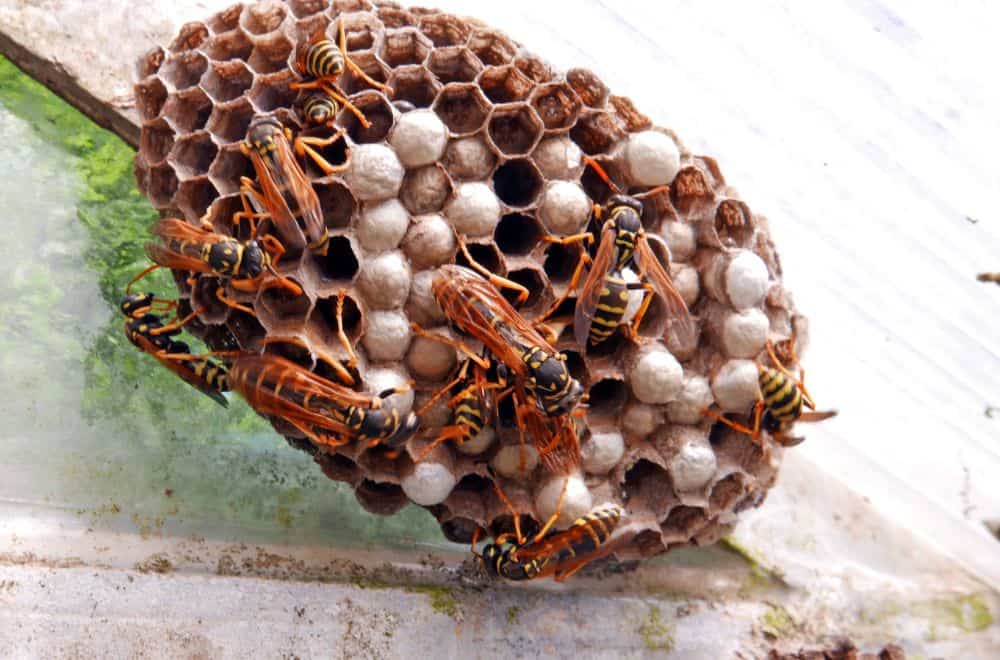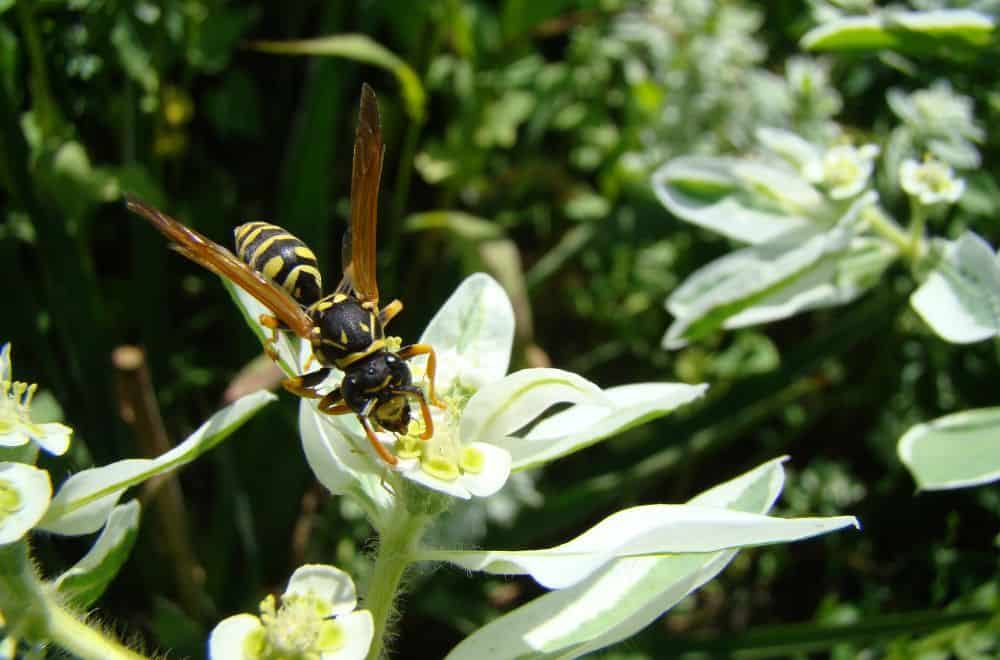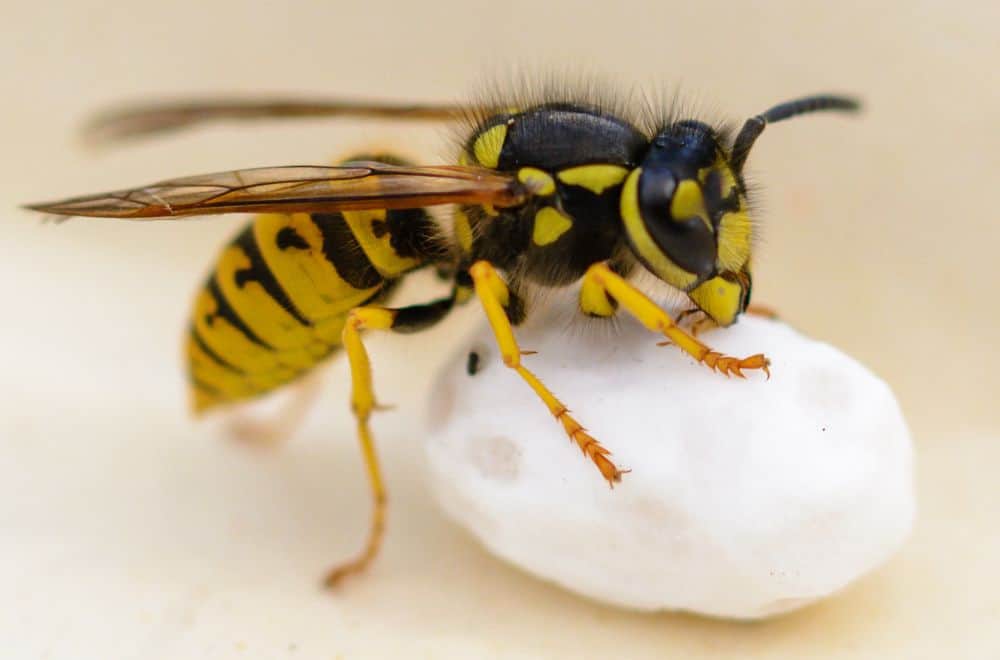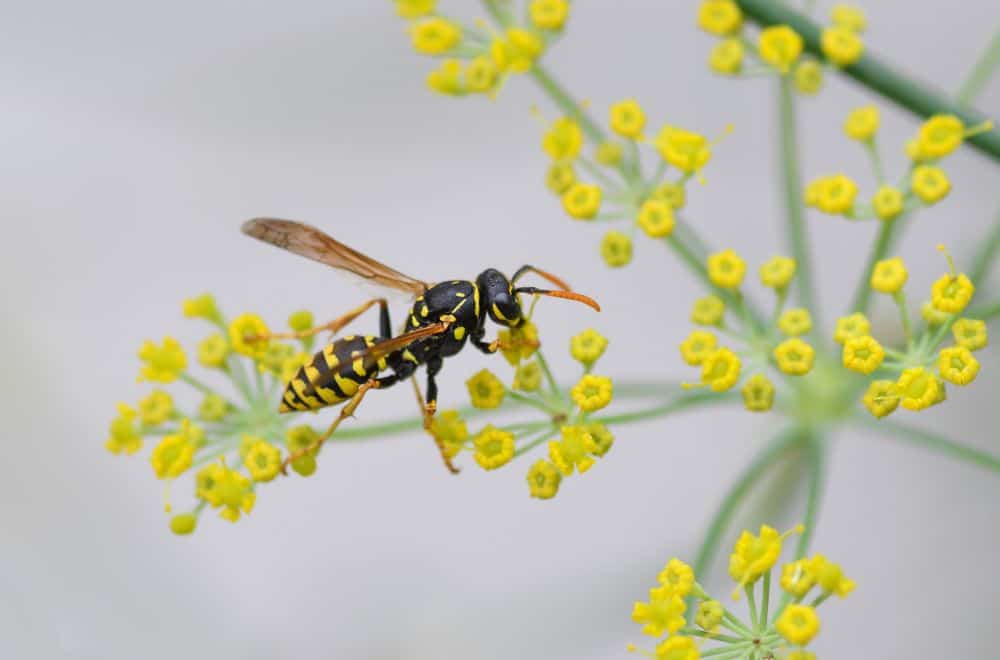When a bee stings you, it dies shortly after because it disembowels itself trying to pull its stinger free. So it really does hurt them more than it hurts you. But wasp stings are far more painful. They contain venom, and the wasp can go on its merry way and live to sting another day! This makes them significantly scarier than bees, so let’s find out why you attract wasps.
How to Identify a Wasp
Wasps are flying insects with tiny waists, curled bodies, and distinct stingers at the tips of their tails. They have four wings, five eyes, and minimal hair on their bodies. The most well-known species of wasps are yellowjackets and hornets. And although their sting can be quite painful, most wasps feed on nectar. They only need protein to lay eggs and raise their babies.
A female wasp may attack an insect, bird, or small animal so she can lay eggs in it. When her babies hatch, they’ll feed on the protein during their larva and pupa stages before molting into adult wasps. Many times, this food source is paralyzed but kept alive so that the baby wasps can feast on fresh, uncontaminated meat. And only female wasps have stinging tails.
In the queen, the tip of her tail is her ovipositor which she uses to lay eggs, so she doesn’t sting. And in male wasps, their tails end in the pronged genitalia that they use to mate. These can sometimes prick human skin if you provoke them, but they don’t have any venom so they don’t do any damage. Half the time, a male wasp ‘sting’ doesn’t even hurt or break your skin.
The Lifecycle of a Wasp

When they’re not terrifying you with the prospect of shuddering pain, wasps can be quite useful. Since they eat nectar, they help us pollinate plants. And female wasps often attack other insects and household pests. Workers might kill them for protein that they carry back for the colony’s babies while other wasp species use the creature itself as a spot to lay eggs.
Most wasps lead solitary lives, laying their eggs in a zombie captive and perpetuating their population in isolation. Other wasps live in colonies led by a queen. Only the queen lays eggs while sterile female worker wasps hunt for food and tend the young. Male wasps are mainly used to mate with the queen, who lays 200 to 300 eggs every day and releases pheromones.
These pheromones help her regulate the colony by ensuring she’s the only reproductive female. If she dies, the pheromones stop and the workers can suddenly lay eggs. But to maintain the matriarchy, any eggs laid by these secondary queens are always male, so they will mate with her to produce more eggs and ensure she’s still the only queen in their nest.
The Role of Social Class in Wasp Colonies
Queens mate as soon as the drones mature, then they typically hibernate through winter and begin to lay their eggs in spring. Communal wasps are described as eusocial and live in nests made of saliva and wood pulp. And the various species can range in size from 0.15mm to 2 inches. Female wasps – whether she’s a colony queen or a single lady – have four options.
Eusocial queens lay their eggs in special cells within the nest. She raises the first batch of eggs herself. Once her first workers are all grown up, they take over childcare duties so she can focus on making more babies. Wasp larvae mostly eat protein, so some worker wasps go out and kill bugs or small birds and rodents for meat which they bring back to their babies.
Since workers can’t readily digest the protein, they offer it to larvae while it’s raw. The larvae digest these bugs or dead animals and absorb the nutrients, excreting a nutrient-rich fluid that their nannies and the queen can feed on. Usually, the youngest workers babysit while older workers hunt for meat and fetch construction materials they later use to build the nest.
How Solitary Wasps Propagate

Option two is for a female wasp to target a host insect like a spider, cockroach, or cicada and sting it. Her venom paralyzes the insect and in some cases, the wasp can then direct its zombie prey to a preferred nesting spot. She will lay her eggs inside the creature’s body and as the eggs hatch, the larvae feed on the animal until they develop cocoons for their pupae.
Option three is for a wasp to lay her eggs amid the eggs of other wasps. The other wasp mom will unknowingly raise them for her. And finally, a female wasp might lay her eggs inside a fruit or vegetable. These baby wasps cause the plant to develop tumors called galls. They hide the wasp larva and protect it from predators that may attack it while it’s vulnerable.
For solitary parasitic wasps, the egg will emerge from its host as an adult, ready to start a new family. Its mother doesn’t need to be around because she left it in a self-sustaining spot with all the food and warmth it needs. But in colonies, the workers will feed larvae until they pupate and molt into grown wasps. The new worker wasps then step into their colony roles.
The Life Stages of a Wasp
In all four reproductive systems, eggs take a week to hatch, become larvae for about two weeks, then spin cocoons and pupate for another two weeks. The timing is really important, especially in colonies. Typically, a young queen leaves the nest where she was born to mate and start a new one. These nests are made of multiple honeycomb cells, one for each egg.
She builds the first few cells herself, lays her first batch, and looks after her new babies. They grow into worker wasps and help her set up, gradually expanding the nest over the next 4 to 6 months. They also help her take care of subsequent babies so she can focus on laying eggs. In the fall, she lays special eggs that grow into queens and drones, but drones mature faster.
To encourage these guys to go out and mate with young queens, wasp workers sometimes practice male stuffing. They push his head into a cell and press his tummy, threatening to sting and trapping him there for 5 to 6 minutes. This way, he can’t eat the food intended for female wasps and his discomfort sends him to find a new queen. He dies soon after mating.
How Wasp Colonies Collapse
Once the teenage queens are impregnated, they fly away, finding safe spots to sleep through the winter since most nests don’t survive the cold. The young queens hide in old buildings, cracks in rocks, or crevices in trees. Next spring, they wake up, find new nesting spots, lay their eggs, and restart the cycle. Since they sleep through winter, wasp queens live for a year.
But worker wasps don’t live long – just two to three weeks – and males barely survive the mating season since the workers will no longer feed them. When her teenage queens leave, and with winter making food harder to find, the old queen dies with the rest of her colony. Meanwhile, since solitary wasps have no communal support, they only live for one season.
Wasps have a pretty predictable lifestyle. In colonies, workers eat nectar for energy then kill insects and small creatures to feed their queen and her babies. They sometimes scavenge exposed meat when they can’t find fresh prey, so they might nibble on pet food or anything you leave on the counter. Drones never learn to hunt so once they mature, they mate and die.
11 Reasons Why You Attract Wasps

As we mentioned, worker wasps only live a few weeks, but constant cycles of new workers show up to maintain the colony. Apart from feeding babies and expanding the nest, they protect the nested pupae from predators while their cocoons are vulnerable. This life path makes it easy to figure out why you attract wasps to your home, so let’s look at a few reasons.
- Your vegetable patch has bugs and worms that worker wasps like to hunt.
- You’re raw feeding your pets and the fresh meat is attractive to wasps.
- You’re growing the type of vegetables that wasps like to nest in.
- You’re farm or garden has colorful flowers whose nectar is favored by wasps.
- Your home is a convenient spot for young queens to hibernate during winter.
- Your yard is a haven for tarantulas, cicadas, or roaches that solitary wasps infest.
- You have a lot of sweet-smelling fruits and fizzy drinks out in the open.
- Your trash is full of protein-rich items like eggs, fish, meat, and dairy.
- You’ve used flowery colors and scents in your home décor.
- Your yard has rotting wood that’s perfect for building wasp nests.
- You have a pond, fountain, bird bath, or tank that’s a reliable wasp water source.
The next step is figuring out how to get rid of these wasps. They can be useful for pest control but if they keep biting the humans in your home, you probably want them gone. Eliminate their food sources by blocking access to any water, flowers, vegetables, or protein pet food they’ve been snacking on. You can use bug screens, netting materials, or greenhouse plastic.
How to Keep Wasps Away
Keep the pet food (and meaty human food) covered and/or supervise your pets while they eat. Don’t leave their leftovers exposed. Plant wasp repellents around your home – they hate cloves, lemongrass, and aromatic herbs. Observe the wasps to see how they access the house and block any gaps or cracks they might be using to sneak in. You can set baited wasp traps.
Cover any sugary or fizzy drinks that might mimic nectar in the eyes of a wasp. You can also use pesticides to kill any insects that the wasps may be subsisting on. Wasps are attracted to trash, fallen fruit, or dead animals, so keep an eye out. You may be tempted to remove a wasp nest yourself using targeted wasp sprays, but that’s risky, so call a professional exterminator.
Do you know any interesting trivia about wasps? Share them in the comments section below!
